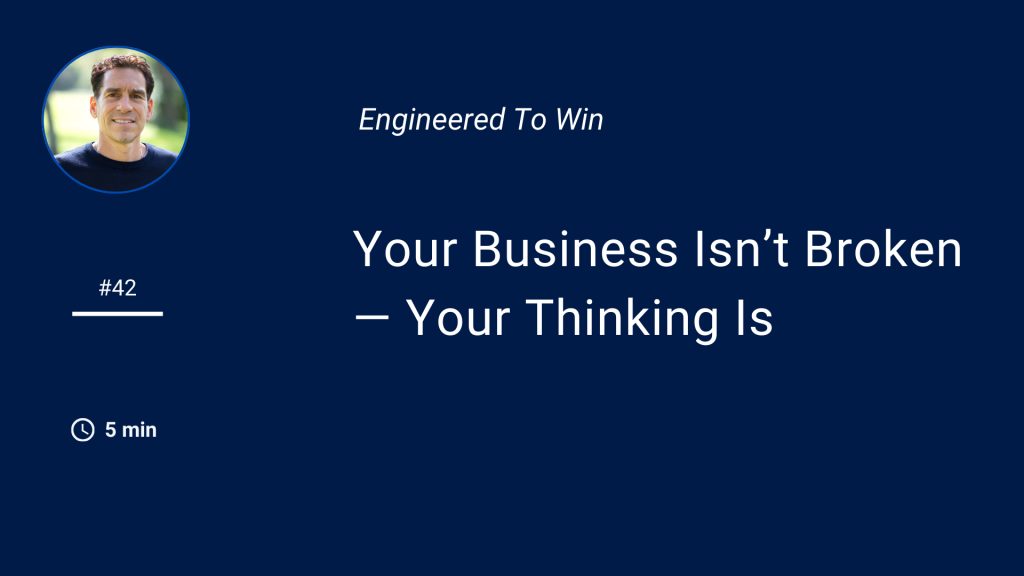The Hidden Challenge Most Founders Overlook
You’re a high-performing entrepreneur.
You’ve built a team. Set goals. Pushed hard.
But you’re still feeling overwhelmed.
Still solving the same problems over and over again.
Here’s why:
You’re solving symptoms, not systems.
And that’s the real reason your business keeps hitting invisible walls.
Why Solving Symptoms Keeps You Stuck
Let’s get specific.
When your operations stall or results slow down, you probably:
- Reorganize your team
- Launch a new campaign
- Hire a new vendor
- Redefine your goals
But these are all surface-level fixes. They might ease the pressure temporarily—but they don’t address the real issue.
Because underneath all of it is this truth:
The root of every recurring problem is a system of decisions, behaviors, and beliefs that you haven’t uncovered yet.
That’s the real problem.
And it’s buried deep in how you think, decide, and lead.
The Broken Pipe Metaphor: What You’re Not Seeing
Imagine this:
Water is dripping from your ceiling.
You patch the drywall. Move the furniture. Mop the floor.
But the drip keeps coming back.
Why?
Because there’s a cracked pipe buried under the foundation—completely out of sight.
And until you dig it up and fix it, you’ll be stuck in an endless loop of cleanup.
This is how most CEOs run their business.
They solve the leak, not the pipe.
That pipe? It’s your operating system. Your default way of thinking, reacting, and leading.
Until you address that, nothing truly changes.
Why Common Solutions Fail to Create Real Progress
Let’s look at what most CEOs try:
- Setting more aggressive goals
- Hiring more people
- Adding more tools or automation
- Reading more books or joining more masterminds
- Working longer hours
These are efforts to fix what’s visible.
But they ignore the system that created the problem in the first place.
The real leverage is upstream.
When you change the system, the problems downstream stop showing up.
Real Story: Peter the Dentist Who Reclaimed His Time and Identity
Peter was a successful dentist. His practice was growing fast.
But he didn’t want more chaos—he wanted clarity.
He told me:
“I don’t want a bigger business. I want a smarter one.”
Here’s how we upgraded Peter’s internal and external systems:
Step 1: Designed Personal Standards
Peter created a set of visible, weekly-reviewed standards. This helped him shift behavior, build consistency, and anchor to his future self—not his old role.
Step 2: Delegated & Systematized
He hired and trained two team members to handle content and built a media funnel to automate the patient journey—freeing him from marketing execution.
Step 3: Mapped Client Retention
Peter printed a list of his top 100 patients. He began outreach and targeted groups like police stations and fire halls with branded campaigns.
Step 4: Streamlined Tools & Tech
We replaced scattered tools with one CRM, added AI automations, and created GPTs to handle repetitive decisions.
Step 5: Closed the Identity Gap
We defined Peter’s Expectation Bridge—the gap between his current role and future self—and built small, daily habits to close it.
Step 6: Reclaimed Time
With a new baby on the way, we built a system that would allow Peter to step back while still earning, growing, and leading with intention.
The Outcome?
Peter now checks in on his business once a month.
His words:
“I feel great. I feel safe knowing the practice is stable. I’m enjoying the income, the time, and the investments it creates.”
He’s no longer holding everything together.
He’s built a practice that runs without him.
That’s not just growth. That’s transformation.
A Better Way to Approach Business Problems
If you’re still reacting to the same problems:
- Team bottlenecks
- Marketing stress
- Time scarcity
- Revenue plateaus
Then the problem isn’t external.
It’s the system that made the problem inevitable.
When you fix the system, you:
- Make better decisions
- Remove recurring fires
- Gain time and headspace
- Scale with less resistance
What To Do Next (Action Plan)
Here’s how to begin:
Step 1: Identify Your Recurring Symptoms
Write down 3 problems that keep repeating in your business.
Step 2: Look Upstream
Ask: What system of beliefs, habits, or decisions is creating this problem over and over?
Step 3: Change the Input
Pick one small upgrade that would shift the system—delegate, remove, automate, simplify, track.
Start there. Let the system evolve one decision at a time.
Final Thought: Systems Create Safety
Most CEOs are not in danger of failure.
They’re in danger of success without fulfillment.
The key isn’t to do more.
The key is to do less, but better.
Fix the source, not the symptom.
Upgrade the system, and everything changes.
Ready to build a smarter business?
I help growth-stage CEOs, dentists, and entrepreneurs install systems that:
- Scale the business
- Simplify operations
- And give you time, peace, and purpose back
Want the solution? → This will get you started.
Because once your system works for you,
You stop surviving your business and start designing your life.




